Eduard 1/72 Spitfire
|
KIT #: |
? |
|
PRICE: |
$15-25.00
|
|
DECALS: |
Two options |
|
REVIEWER: |
Ryan Grosswiler |
|
NOTES: |
Weekend Edition and overtrees |
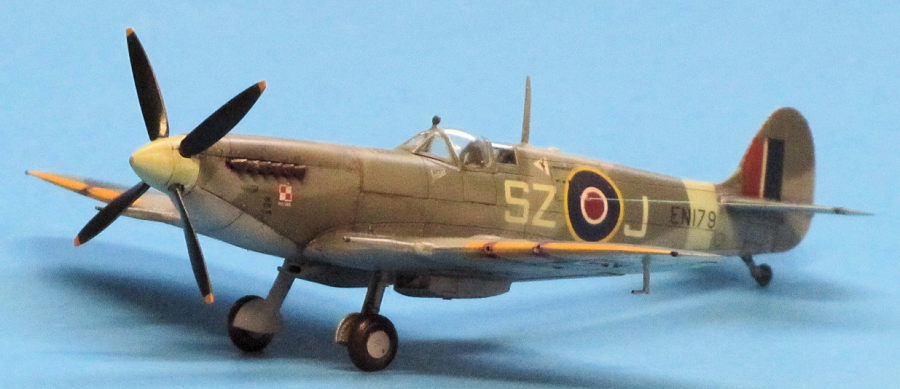
It's hard not to at least like the
Spitfire. You might as well deride the works of Bach and Mozart, like some
of my music-snob friends feel inclined to do for some reason. The last great
work of a talented man in the process of dying way too young, the Spitfire
was one of the greatest dogfighting airplanes ever produced, limited only by
its short range and lack of ability to haul much in the way of ordinance. It
would also subtly change shape over the course of its decade in
developmental life as technological progress and the demands of its use
evolved.
The novice can easily identify in a general sense
early-middle-late Spitfire production on sight, because the aircraft's nose
kept getting longer as it went from the early 10- and 40-series Merlin, to
the longer 60-series Merlin, to the big Griffon engines. Along the way it
kept gaining propeller blades as well, from the two-bladed fixed-pitch
wooden prop on the first few production Mk.Is to the six-bladed
counterrotating unit fitted to the final Mark 47 long after the war.
Throughout all this, however, the basic airframe remained unchanged for most
of the time: it wasn't until the stiff-winged Mark 21 coming on line at the
end of the war that the tooling needed to be altered significantly.
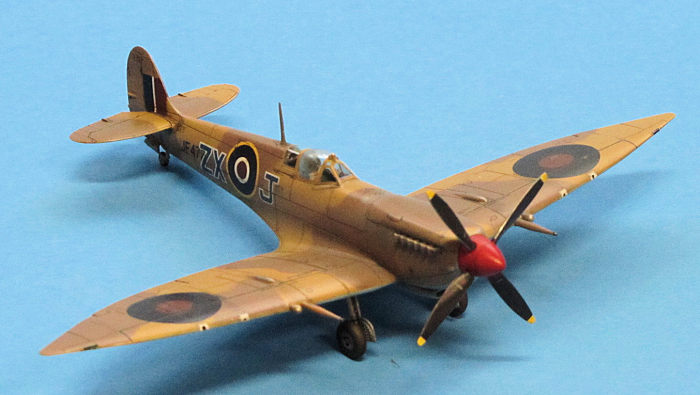 Owing to the fact that they were born out of intense fear, the
mid-production 'four-blade' group of Spitfires, the Marks VII-IX and XVI
with the medium-length nose, were the most numerous of them all.
Owing to the fact that they were born out of intense fear, the
mid-production 'four-blade' group of Spitfires, the Marks VII-IX and XVI
with the medium-length nose, were the most numerous of them all.
The story goes like this: for the first two years of war, the
Spitfire Mk. I had been very much able handle its primary enemy, the
Bf-109E. The German fighter was better in climb rate and inverted flight
(thanks to its fuel-injected engine), the Spitfire balancing this with a
tighter turn radius. Even the introduction of the cleaner, meaner -109F was
balanced by the introduction of the Spitfire Mk.V summertime, 1941.
However, right about this time RAF fighters returning from sweeps
over occupied France began reporting a mysterious new Luftwaffe fighter with
a round engine that was smacking everything the RAF could put up against it
right out of the sky. Including even that Mark V Spitfire--itself the latest
and greatest, just entering service. So much so that the RAF drew back from
offensive combat for a short period. The nasty little Teutonic surprise
would of course turn out to be the previously unknown Fw-190, and a
counterpoint was obviously needed right away. There was a reason the -190's
nickname in English was Butcher Bird. However, the new Hawker Typhoon wasn't
living up to expectations and a totally fresh fighter design could be
expected to require fully four years to design, develop, and deploy. The
Brits, still on their own in the west, just didn't have that long. Things
were looking dim, but in one of those odd coincidences that mark the twist
and turns of war, a solution just happened to be on hand.
High-altitude reconnaissance versions of the Junkers Ju-86 had
appeared a year or two earlier over the British Islands, coming in for their
photo runs sometimes in excess of 40,000 feet. While carrying no bombs,
these unreachable intruders had put the RAF Air Ministry into understandable
fits about the war potentially moving to these altitudes. They therefore
went about hyperactively developing the means to engage in combat way up
there, and two aircraft had resulted: 1) that weirdly bulbous, pressurized
version of the Wellington bomber, and 2) the gawky Westland Welkin
interceptor. Neither type would end up firing a shot in an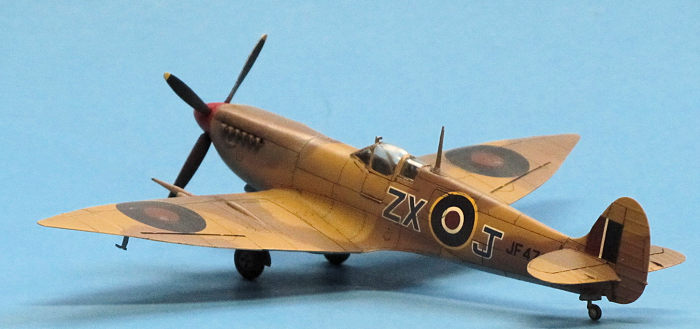 ger as their
intended battleground around the tropopause would never actually come to
pass over Europe. However, a specialized engine developed for both
airplanes was available as a result: the Merlin 60. This involved a standard
Merlin cylinder block with a two-stage supercharger added. The innovation
here was two blowers mounted in series with a new cooling element--the
intercooler--mounted between the two, lowering the temperature of the intake
charge even further, thus increasing the density of intake air, thus more
bang. This new accessory section increased brake horsepower 30% over the
earlier Merlin 45 while retaining the same frontal area and increasing the
length of the engine less than a foot. It could probably be slapped on the
firewall of the existing Spitfire to give Britain the fighter it needed.
ger as their
intended battleground around the tropopause would never actually come to
pass over Europe. However, a specialized engine developed for both
airplanes was available as a result: the Merlin 60. This involved a standard
Merlin cylinder block with a two-stage supercharger added. The innovation
here was two blowers mounted in series with a new cooling element--the
intercooler--mounted between the two, lowering the temperature of the intake
charge even further, thus increasing the density of intake air, thus more
bang. This new accessory section increased brake horsepower 30% over the
earlier Merlin 45 while retaining the same frontal area and increasing the
length of the engine less than a foot. It could probably be slapped on the
firewall of the existing Spitfire to give Britain the fighter it needed.
There remained intimidating questions. Would that wispy airframe
absorb the massive increase in torque forces without damage? Would pilots be
able to stuff enough rudder in to counteract the asymmetrical yank of the
big new four-bladed prop on throttle-up? The engineers immediately went to
work dealing with these problems with their slide rules and calculations,
putting into development the Marks VII (pressurized) and VIII
(unpressurized) as a solution. But a new Spitfire was still needed right
now, damn it, and the workshops in fact did end up simply slapping the new
Merlin on the nose, and adding another radiator under the wings while they
were at it. This was the Mark IX. The dangers above were simply accepted
with a shrug in the face of wartime emergency, part of the daily gamble. The
need was in fact so pressing that the first examples were actually Mark V
airframes pulled from frontline squadrons and converted at the depot level
while proper production lines were hurriedly set up, and the very, very
first ones sported hand-shaped, individually-fitted engine cowls in a total
lash-up.
By now the RAF had gone almost a year in this painful situation.
The souped-up Spitfire IX finally appeared over the Channel and pilots began
scoring their first kills against the dreaded Focke-Wulf at the end of July,
1942. When released for squadron service, it immediately restored the
technological balance, the Luftwaffe never able to properly exploit the
Fw-190's superiorities anyway owing to that huge and ultimately catastrophic
project to the east, the USSR. Also, it meant that because of frantic
production efforts that the Mark IX appeared before the properly-engineered
VIII, and because of the anxieties under w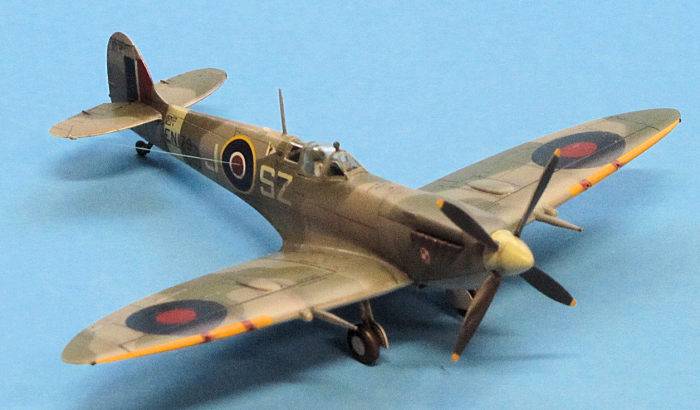 hich the 'nine was initially
produced, several ironies resulted: this 'temporary solution' would
outnumber all other marks except the V by the end of production. It was kept
in Europe by the RAF while the VIII was generally passed off to the
Australians and their ilk elsewhere. Finally, it had a longer and more
storied postwar career (particularly surrounding the dramatic emergence in
1948 of the state of Israel), though this may have been a by-product of its
superior numbers.
hich the 'nine was initially
produced, several ironies resulted: this 'temporary solution' would
outnumber all other marks except the V by the end of production. It was kept
in Europe by the RAF while the VIII was generally passed off to the
Australians and their ilk elsewhere. Finally, it had a longer and more
storied postwar career (particularly surrounding the dramatic emergence in
1948 of the state of Israel), though this may have been a by-product of its
superior numbers.
Even as the ultimate Spitfire with the even more powerful Griffon
engine entered production and service in 1944, these Merlin-60 powered
versions remained in production alongside, gradually shifting to a role of
ground attack. The final Merlin Spifire Mark XVI was merely an IX with an
American-built Packard Merlin, now pouring in from that side of the
Atlantic, courtesy of the P-51's engine upgrade. Later examples of this XVI
were given the low-cut fuselage and bubble canopy which was appearing at the
same time on the Griffon Spits. Since the various details (the long
carburetor intake, smaller cannon bulges, bigger pointy rudder, etc.) of the
VIII gradually were incorporated over the course of the IX's production,
with the exception of that properly-engineered fuselage, the only certain
way to tell the two solutions to the original problem apart visually is the
telltale retractable tailwheel of the VIII.
Being what it is, the wartime Spit has always been very well
served in all scales of plastic. For these mid-series subtypes, we've had
many in 1/72, the KP and Frog examples being the best of the old school.
Then the scale modeling boom of the '90s gave us a few new ones with the
mandatory recessed panel lines: a comprehensive range of resin/photoetch
kits by CMK, extremely expensive and not easy to find; a flawed Mark IX by
Italerei; and finally a set of IX/VIII kits from Hasegawa, very good if
still a tad pricey (and marred only by the minor points of prop blades too
skinny and tailwheel area generalized to cover both Mk. VIII and IX). These
last have been the standard for the two decades which followed, as New
Airfix hiccuped and released a sound but very uninspired IX in 2009.
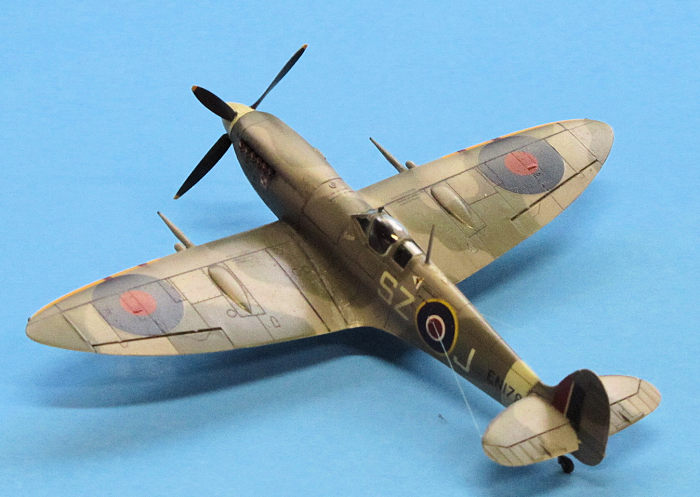 Come 2016, Eduard blew into the octagon with this family of kits
by scaling down their 1/48th line. The result is a little bit mind-blowing,
particularly for a kit that costs less than $20 on the street. Given that
Eduard got their start as one of the pioneering aftermarket suppliers, there
is also a dizzying (and expensive) array of resin and photoetch accessories
to cover all these boxings.
Come 2016, Eduard blew into the octagon with this family of kits
by scaling down their 1/48th line. The result is a little bit mind-blowing,
particularly for a kit that costs less than $20 on the street. Given that
Eduard got their start as one of the pioneering aftermarket suppliers, there
is also a dizzying (and expensive) array of resin and photoetch accessories
to cover all these boxings.
I use the term "kit family", because Eduard took the time to cut
completely different molds to account for the retractable vs.
non-retractable tailwheel fuselages as well as the low-back of the late XVI,
plus wings with both the early and late cannon bulges. These are united to
common sprues covering the different horizontal stabilizers, wingtips,
carburetor intakes, and subtly different upper engine cowls. Two more sprues
comprehensively cover differences in armament, rudders, tailwheels, wheels,
tires, external fuel tankage, exhaust pipes, wing root bulges, landing gear
struts, and (seriously!) seat bulkheads and gear well interiors.
Whatever your building experience, you'll end up with a giant pile
of unused parts upon conclusion! I've already set aside an assortment for my
Sword Mk. XIVE.
I was so thrilled with this kit that in blind faith I bought
several variations, plunged carelessly into the VIII, whipping the parts
together just as soon as I could merrily cut them from the sprue. Suffice to
say that with hindsight I don't recommend the 'slammer' approach to this
particular kit, because it bit back. I was rewarded with quite few seams
which required tedious and time-consuming filling, sanding and rescribing.
All these different options make up for a very complex, modular kit for a
1/72 single-engine fighter, especially at the front end. I did recover, but
it was a bigger pain in the ass than it should have been. That little bugger
was taunting me! I wanted an immediate re-match.
The Mark IX was therefore dealt with differently, lessons learnt
thoughtfully applied. I started by assembling the entire cockpit (except the
control column and gunsight) with slow-setting cement to the left-hand
fuselage half. If you're building the model with the canopy closed, add the
entry door at this time--and slice off the flanges in its frame: you can
close it more flush that way. The other fuselage half was dry-fitted and
then taped to the first, the assembly left to cure. Check the canopy parts
for correct fit while the fuselage is in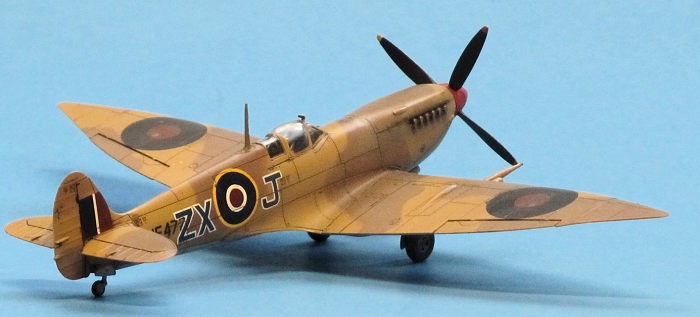 this state. The following day the
halves were opened and the cockpit painted and weathered (If you're
depicting the canopy opened, a separate, enlarged piece {#C12/C13} is used.
Sand down the thickness of the entry door as much as you are able or use a
resin aftermarket replacement)
this state. The following day the
halves were opened and the cockpit painted and weathered (If you're
depicting the canopy opened, a separate, enlarged piece {#C12/C13} is used.
Sand down the thickness of the entry door as much as you are able or use a
resin aftermarket replacement)
Next, the upper cowling halves were cemented not to each other
but to their corresponding fuselage halves, then the fuselage halves were
once again taped accurately together and with the cemented joints still
pliable, the upper cowl halves gently nudged and poked here and there 'til
they were lined up properly. The separate lower cowl was also test-fitted at
this time; no issues.
While this assembly was again set aside to cure I sanded down the mating
surfaces of the upper wing trailing edges (Parts G33/35) just a little bit,
1/64" /.2mm or so. This will eliminate a tiny but annoying little step at
that location. Also, per standard procedure for wingtip parts engineered
this way glue the wing tips to the same upper wing parts and ensure they're
flush with the upper camber: it's much easier to take care of any fit
discrepancy if it appears at the wing leading edge rather than on top or
bottom!
The rest of the assembly was straightforward. Except for one
thing: Eduard has molded the forward wing roots separately to cover still
more variation. Just as you did with the upper cowls, cement these little
pieces to the fuselage shortly before you fit the wing assembly to make sure
they line up properly.
Oh, and the radiators, too. They're four parts each, six with
photoetch, and they're 'handed'. Cement the sides and top and yes, you
guessed it, dry-fit them to the wing to let them cure. Then fit and paint
the etch radiator detail, if appropriate, glue the separate flap in the
desired position, and glue the whole business in place.
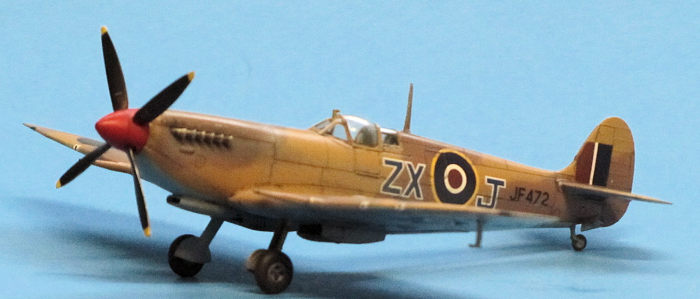 One more firm kick in the crotch was experienced with the tiny
main wheels, engineered incomprehensibly into four parts. Each. Save
yourself the swelling, ice pack, and octave change by purchasing
BarracudaCast's resin wheels, available in a money-saving 3-pack.
One more firm kick in the crotch was experienced with the tiny
main wheels, engineered incomprehensibly into four parts. Each. Save
yourself the swelling, ice pack, and octave change by purchasing
BarracudaCast's resin wheels, available in a money-saving 3-pack.
Having engineered things this way, Eduard--with a Lee Harvey
Oswald smirk on its face--offers us the wheels, radiator housings, upper
cowling, and lower cowling, all as single-piece resin castings. Draw from
that what you will.
Finishing was nothing mind-blowing here, just my usual combination
of enamels sealed in by Future before a wash and other weathering. I did
take the time to really clean things off the second time around so all that
fine surface detail would mean something. I used a combination of the Eduard
kit decals, plus Fundekals and Kagero to provide individual markings for
Texan Lance Wade's Mk. VIII and a Mk.IX from the RAF's Polish-manned 131
Wing. All these products performed well.
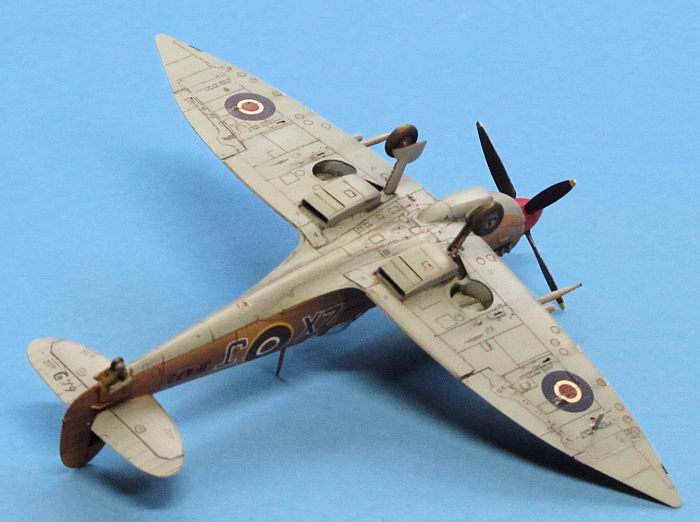 Despite almost everything I have written above, I conclude that
this is a bold, magnificent little kit--a true milestone in the 1/72
world. I slightly regret passing on the Quattro Combo. But--if you haven't
been picking up what I've been throwing down--it's a fiddly 'un! World War
II single-engine fighters are normally an excellent entry point for the new
modeler, but that's very much not the case here! Take your time, dry-fit,
and think several steps ahead.
Despite almost everything I have written above, I conclude that
this is a bold, magnificent little kit--a true milestone in the 1/72
world. I slightly regret passing on the Quattro Combo. But--if you haven't
been picking up what I've been throwing down--it's a fiddly 'un! World War
II single-engine fighters are normally an excellent entry point for the new
modeler, but that's very much not the case here! Take your time, dry-fit,
and think several steps ahead.
If you want Eduard's resin and photoetch goodies and canopy
masks, buy the Profipack or Quattro Combo kits. These accessories by
themselves are prohibitively expensive, at least here on the left side of
the Atlantic. The company's unique Overtrees offerings--only a buck or two
cheaper than the street price of their Weekend editions are therefore not
really a good deal either unless you have all these bits and a set of decs
accumulated already.
The moniker "Spitfire" is appropriate here. Sort of like a testy
relationship with a complex and maintenance-intensive but ultimately
beautiful and good woman, this kit will frustrate the unwary and reward the
patient.
Hands-down the best Spitfire in 1/72. Caveat emptor!
Scutts, Jerry. Spitfire In Action. Squadron-Signal Publications, 1980
Sweetman, Ethel, Watanabe, et al. The Great Book of World War II
Airplanes. Bonanza Books, 1984
Price, Alfred. Late Marque Spitfire Aces. Osprey Publishing, 1995
Ryan Grosswiler
7 December 2020
Copyright ModelingMadness.com. All rights reserved.
If you would like your product reviewed fairly and
fairly quickly, please
contact
the editor
or see other details in the
Note to
Contributors.
Back to the Main Page
Back to the Review
Index Page
Back to the Previews Index Page


 Owing to the fact that they were born out of intense fear, the
mid-production 'four-blade' group of Spitfires, the Marks VII-IX and XVI
with the medium-length nose, were the most numerous of them all.
Owing to the fact that they were born out of intense fear, the
mid-production 'four-blade' group of Spitfires, the Marks VII-IX and XVI
with the medium-length nose, were the most numerous of them all.  ger as their
intended battleground around the tropopause would never actually come to
pass over Europe. However, a specialized engine developed for both
airplanes was available as a result: the Merlin 60. This involved a standard
Merlin cylinder block with a two-stage supercharger added. The innovation
here was two blowers mounted in series with a new cooling element--the
intercooler--mounted between the two, lowering the temperature of the intake
charge even further, thus increasing the density of intake air, thus more
bang. This new accessory section increased brake horsepower 30% over the
earlier Merlin 45 while retaining the same frontal area and increasing the
length of the engine less than a foot. It could probably be slapped on the
firewall of the existing Spitfire to give Britain the fighter it needed.
ger as their
intended battleground around the tropopause would never actually come to
pass over Europe. However, a specialized engine developed for both
airplanes was available as a result: the Merlin 60. This involved a standard
Merlin cylinder block with a two-stage supercharger added. The innovation
here was two blowers mounted in series with a new cooling element--the
intercooler--mounted between the two, lowering the temperature of the intake
charge even further, thus increasing the density of intake air, thus more
bang. This new accessory section increased brake horsepower 30% over the
earlier Merlin 45 while retaining the same frontal area and increasing the
length of the engine less than a foot. It could probably be slapped on the
firewall of the existing Spitfire to give Britain the fighter it needed. hich the 'nine was initially
produced, several ironies resulted: this 'temporary solution' would
outnumber all other marks except the V by the end of production. It was kept
in Europe by the RAF while the VIII was generally passed off to the
Australians and their ilk elsewhere. Finally, it had a longer and more
storied postwar career (particularly surrounding the dramatic emergence in
1948 of the state of Israel), though this may have been a by-product of its
superior numbers.
hich the 'nine was initially
produced, several ironies resulted: this 'temporary solution' would
outnumber all other marks except the V by the end of production. It was kept
in Europe by the RAF while the VIII was generally passed off to the
Australians and their ilk elsewhere. Finally, it had a longer and more
storied postwar career (particularly surrounding the dramatic emergence in
1948 of the state of Israel), though this may have been a by-product of its
superior numbers. Come 2016, Eduard blew into the octagon with this family of kits
by scaling down their 1/48th line. The result is a little bit mind-blowing,
particularly for a kit that costs less than $20 on the street. Given that
Eduard got their start as one of the pioneering aftermarket suppliers, there
is also a dizzying (and expensive) array of resin and photoetch accessories
to cover all these boxings.
Come 2016, Eduard blew into the octagon with this family of kits
by scaling down their 1/48th line. The result is a little bit mind-blowing,
particularly for a kit that costs less than $20 on the street. Given that
Eduard got their start as one of the pioneering aftermarket suppliers, there
is also a dizzying (and expensive) array of resin and photoetch accessories
to cover all these boxings. this state. The following day the
halves were opened and the cockpit painted and weathered (If you're
depicting the canopy opened, a separate, enlarged piece {#C12/C13} is used.
Sand down the thickness of the entry door as much as you are able or use a
resin aftermarket replacement)
this state. The following day the
halves were opened and the cockpit painted and weathered (If you're
depicting the canopy opened, a separate, enlarged piece {#C12/C13} is used.
Sand down the thickness of the entry door as much as you are able or use a
resin aftermarket replacement) One more firm kick in the crotch was experienced with the tiny
main wheels, engineered incomprehensibly into four parts. Each. Save
yourself the swelling, ice pack, and octave change by purchasing
BarracudaCast's resin wheels, available in a money-saving 3-pack.
One more firm kick in the crotch was experienced with the tiny
main wheels, engineered incomprehensibly into four parts. Each. Save
yourself the swelling, ice pack, and octave change by purchasing
BarracudaCast's resin wheels, available in a money-saving 3-pack.  Despite almost everything I have written above, I conclude that
this is a bold, magnificent little kit--a true milestone in the 1/72
world. I slightly regret passing on the Quattro Combo. But--if you haven't
been picking up what I've been throwing down--it's a fiddly 'un! World War
II single-engine fighters are normally an excellent entry point for the new
modeler, but that's very much not the case here! Take your time, dry-fit,
and think several steps ahead.
Despite almost everything I have written above, I conclude that
this is a bold, magnificent little kit--a true milestone in the 1/72
world. I slightly regret passing on the Quattro Combo. But--if you haven't
been picking up what I've been throwing down--it's a fiddly 'un! World War
II single-engine fighters are normally an excellent entry point for the new
modeler, but that's very much not the case here! Take your time, dry-fit,
and think several steps ahead.